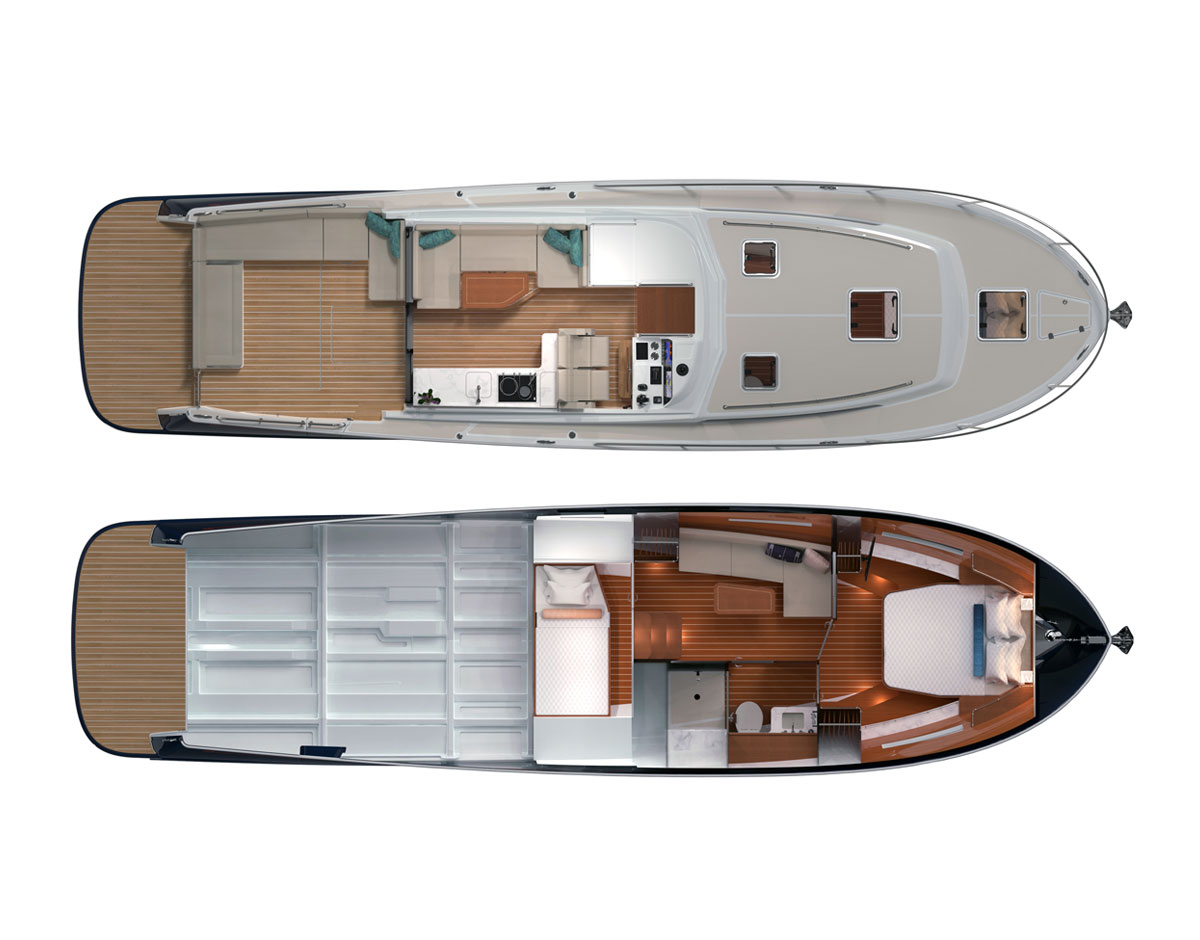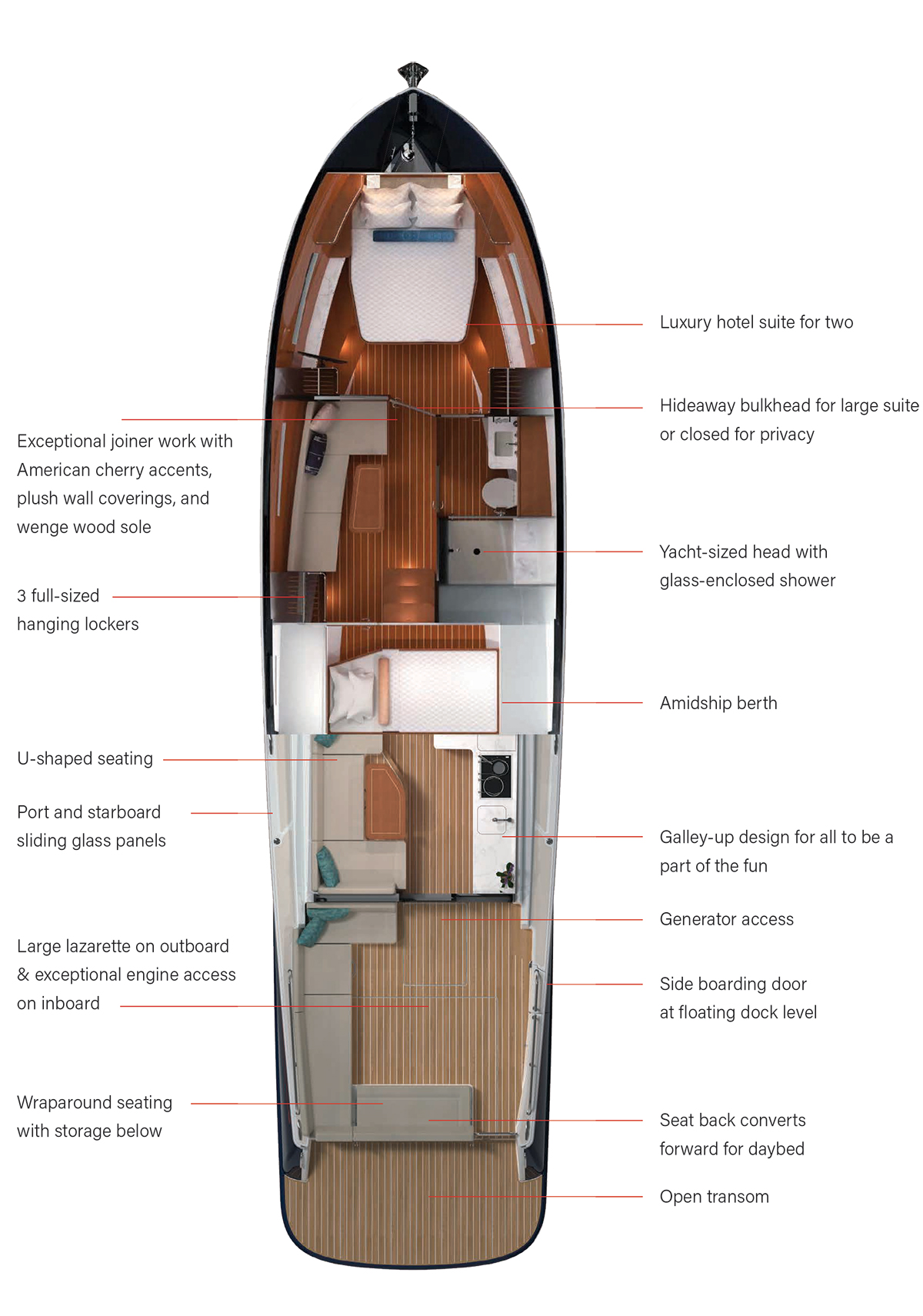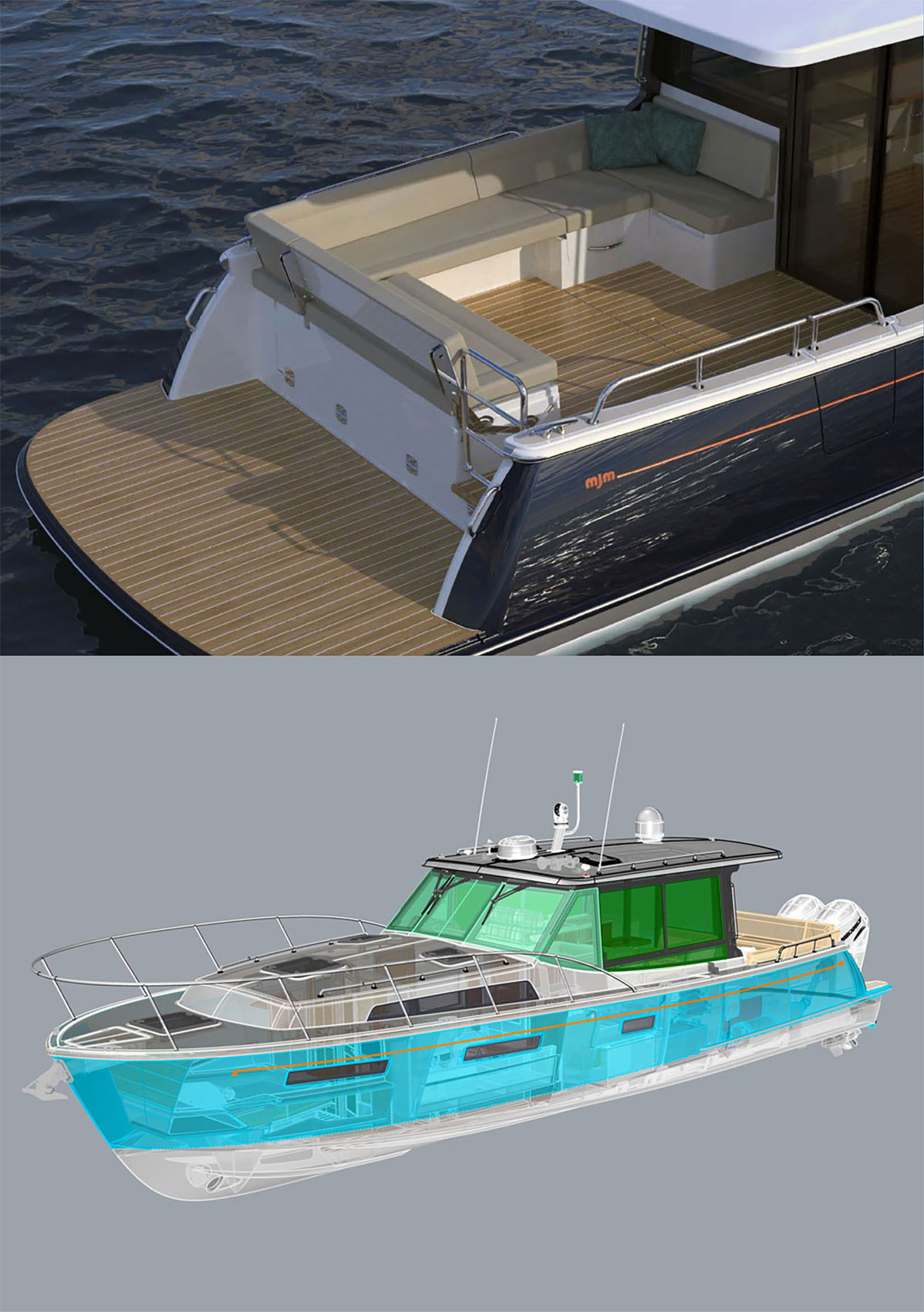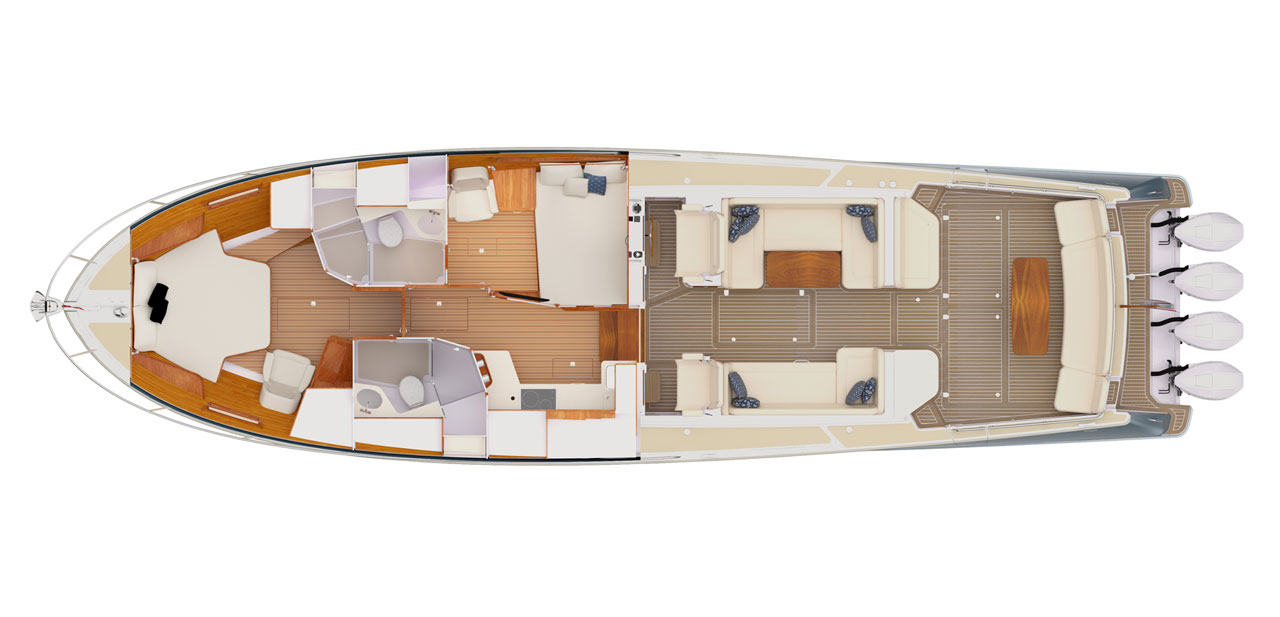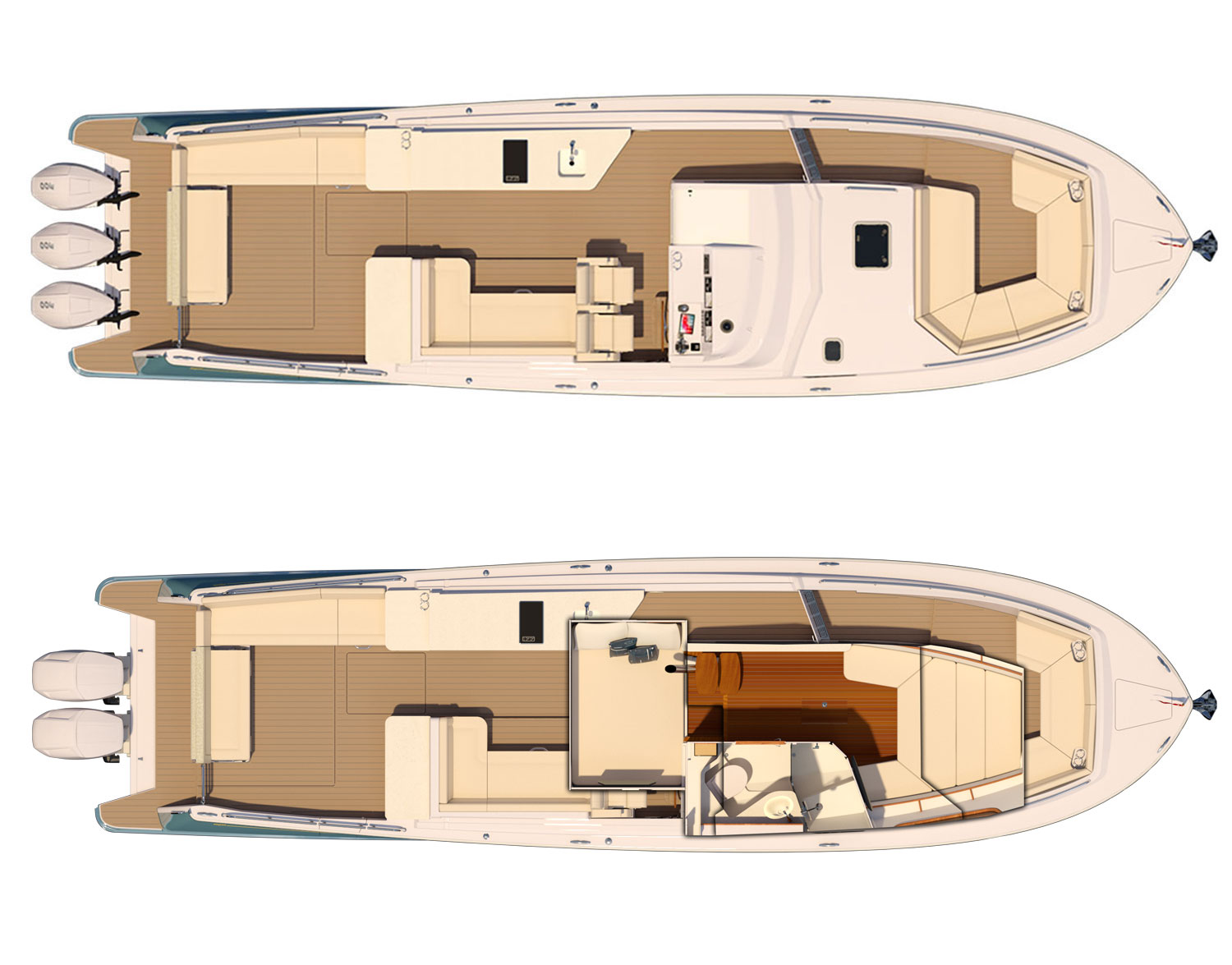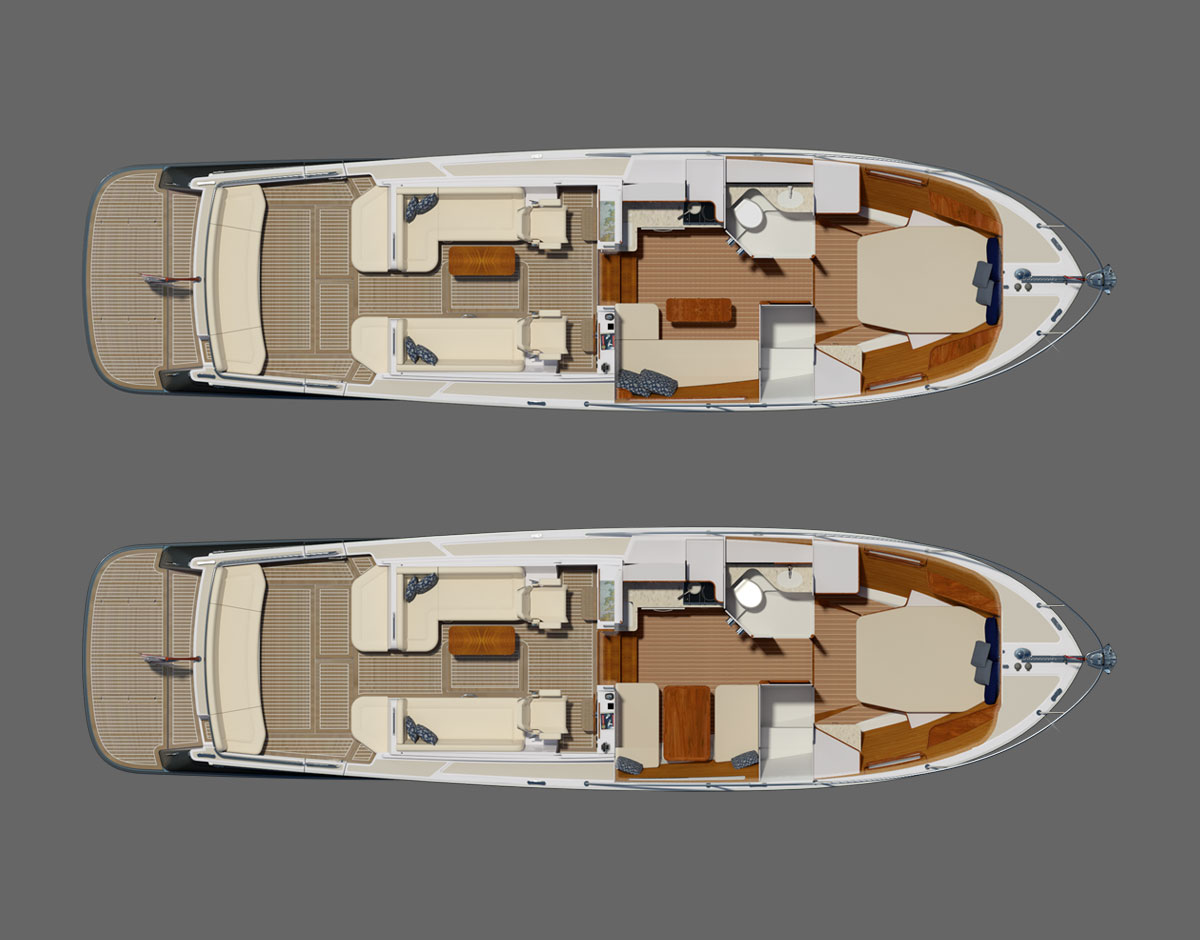MJM Yachts – Innovation Plus
Prospertere: New World Media
Great tales of success oftentimes start with surprisingly shaky beginnings. Such is the case for Bob Johnstone and his lifelong immersion in boating. There were great expectations for him. His dad had sailed in the 1926 Sears Cup (National Junior Championship) and was a member of the Princeton Sailing Team in 1929 when intercollegiate sailing consisted of only Harvard, Yale and Princeton.
Leap forward to the summer of 1936. During the annual parent-child sailboat race in Stonington, Connecticut, Bob’s dad couldn’t wait to have three RLJ names on the trophy (donated by his father). That meant conscripting the latent talents of his 2-year-old son. Our story starts with the infant Bob blowing a huge lead his father had built on the parent’s initial lap. The parent couldn’t touch the tiller on the final child’s lap. Dad’s admonitions of “push-pull, push-pull” seemed to work in practice and for about 30 seconds in the race… but were then met with the terrible-two’s classic response, “NO!” The psychiatrist wife of a sailing friend summed it up years later, “That explains everything. You’ve been trying to make it up to your dad ever since!”

The stunning MJM 50Z at 36 knots!
The break-in period continued in The Summer of ’42. An 8-year-old Johnstone and his childhood friend sailed a 16′ Scamp keelboat from the family anchorage directly onto a shoal on Sandy Point. Mother Libby and Aunt Ginny sailed out in the family’s other 16′ Scamp, planning to give the boys instruction, but were late getting off the mooring to warn the tykes about the shoal. To rescue them, Libby had to sail back to the mooring and row a dinghy half a mile back to rescue the aspiring mariners. The next day, undaunted and intent on making amends while gaining respect as a proper seaman, young Robbie noticed a messy pile of rope in the cockpit. Confidently, he pulled out his handy sailing knife and sliced off the tail of the main sheet. Of course, one couldn’t let the mainsail out downwind after that.

Two weeks later, mainsheet replaced, properly chastised and with confidence of expert seamen, the 8-year-olds boldly ventured westward in the 16′ Scamp, 5 miles down Fishers Island Sound and back, ignoring the inner breakwater limit set for beginners. They made it back home to the mooring just fine, but it didn’t do much to calm Mom, who in a proper snit had called the Coast Guard. Five years later, Johnstone got his first taste of boat building in 1947, helping his parents build a 19′ Lightning in their garage in Glen Ridge, New Jersey. The boat was varnished mahogany with an oak keel and heavy canvas-covered Masonite decks. It was 300 lbs. overweight and leaked like a sieve. But, as Johnstone commented, “There’s nothing like a slow boat to teach one how to make the most of wind and current.”
He did learn. In faster, better-built boats, he became 5-time winner of the Wadawanuck YC’s Junior Championship and won ECYRA Midget, Junior and Lightning Championships. A national finalist in the 1951 Sears Cup himself, he coached the winning crew from Indian Harbor YC the following year; captained a 54′ Herreshoff yawl on the Great Lakes as a summer job; won the Sunfish Venezuelan National Championship, Rainbow U.S Nationals, 1969 Penguin Internationals and National Hospice Regatta; and was runner-up in the J/24 Worlds. He is 3-time winner of the Maine Retired Skippers Race and a winner of the New York YC Queen’s Cup. On his favorite “J” at the time, he has collected more than a dozen wins at Antigua, Block Island, Charleston, Key West and DownEast Race Weeks.

So, sailing credentials established, how about business and marketing roots? After graduating from Princeton and completing a stint as a 2nd Lt. in the artillery school at Ft. Sill, Oklahoma, sailing took a back seat to a 20-year business career and raising a family. He started as production manager, then moved up to CEO, of Quaker Oats subsidiaries in Colombia and Venezuela. Later, having learned the key to business growth was marketing, he transferred out of South America into product management at Chicago headquarters. Within 2 years, he was named Quaker’s 1968 Marketing Man of the Year. Then in the role as director of market strategy, covering 28 business divisions, he developed the Best Performing Brand and Umbrella Trademark strategies ultimately applied to both J/Boats and MJM Yachts brands.

In 1960 when in South America, an inkling of the future occurred in Cali, a landlocked city 3,300 feet up in the Andes’ Cauca Valley. It only took a small pond at the Club Campestre to pull him from tennis where he was club champion. He railroaded a dozen friends into buying model Star boat kits to race on the pond. This 2nd boat building experience (albeit small) and 1st one-design fleet building initiative was a disaster. Bob was the only one to finish building his kit boat. He had more success later in Valencia, Venezuela, on Lake Guataparo, establishing a sizeable Sunfish fleet with its own boathouse. Each with their own Sunfish, Bob and Mary campaigned at weekend regattas off beautiful crescent beaches along the coast.
Bob’s seemingly inevitable transition from “Oats to Boats” gained further traction when founding SAIL Wilmette, a community sailing program. That made the local Sunfish and Hobie Cat dealer one of the most successful in the U.S. Meanwhile, in his spare time, he was starting up large (25+) Soling and 470 fleets at the Sheridan Shore YC, where the inaugural United States Youth Sailing Championship he founded was held. This, while serving as secretary/treasurer of the United States Olympic Sailing Committee. Seemed he had a talent for getting lots of people into sailboats. Finally figuring out his calling at age 41, he became VP marketing for AMF Alcort to resurrect sliding Sunfish sailboat sales as “The boat that everyone should learn on.”
Frustrated after 18 months with AMF’s reluctance to further capitalize on their strong brand position, “I figured two guys with a vision, a fast boat design and $20,000 could do better than a floundering multi-billion-dollar corporation.” Johnstone teamed up with his younger brother Rod in 1977 to incorporate J/Boats, Inc. Rod threw in his 24′ design and Bob, $20,000 and his time, until the business was profitable. That enabled Rod to leave his job selling ads for Soundings. Bob revealed a little-known fact: “It was really Mary behind the scenes that made my move possible. She was keeping the family afloat earning 6 figures running an earlier start-up venture called Naturescapes.”
As president of J/Boats, Bob was the marketing and operations brother. He identified potential market niches and articulated design parameters, wrote the ads, established a professional dealer network and set up licensed builders in the UK, Italy, Argentina, Australia, Japan and South Africa. As chairman of the J/24 Class, he organized regattas, managed the process to earn IYRU International status and published the J/24 Magazine.

J/Boats has become the world’s leading performance sailboat brand with over 14,000 in 36 designs sailing in 41 countries. Twenty-one have been awarded Boat of the Year or Hall of Fame honors. Five have ISAF International Status, qualified for use in World Championships or the Olympics. It’s not unusual to see J/Boats making up 35% of boats racing at major race weeks.

But, alas! Participation patterns in the sport can change with one’s age. By 1996, with Medicare in sight, sailing had become mostly Bob racing with the guys. Mary had competed at the world level with Bob, trapezing on a 470 dinghy and droop-hiking a Soling in hobbles. But at 61, getting blasted by the wind, grinding winches and furling the mainsail had little appeal. The complication was, “I most enjoyed being on the water with Mary.” A Dyer 29 powerboat became their 40th anniversary solution. The sailboat and powerboat reversed roles, the latter becoming the cruiser on short weekends. After 5 years of using the Dyer 29 twelve months of the year, trucked between Charleston, SC, and Northeast Harbor, ME, they figured a larger, more comfortable powerboat was desirable. “There were pretty boats out there that weren’t very functional and functional boats that weren’t so pretty.” To product strategist Bob, having turned over management reins to the next generation at J/Boats, this seemed the time and opportunity to introduce a unique cruising powerboat that was both pretty and functional. And, calculating there were 70 million like-minded Baby Boomers following soon in his wake, this could become an interesting growth business. Brainstorming with son Peter, they agreed that if aesthetics was the No. 1 priority, there was only one powerboat designer to team up with: Doug Zurn. He had done the beautiful Shelter Island 38 for singer Billy Joel. Bob recalls the moment: “Doug told me it would only cost $3,200 to come up with a rendering of a boat I would be happy with. I figured I could lose that, so gave him the go-ahead.” Two weeks later, they met during the 2002 Newport Boat Show. “I wasn’t totally thrilled with the preliminary drawings,” Johnstone confesses. But, after a month exchanging emails and faxes, Johnstone and Zurn finally settled on a design they were both happy with. The MJM 34z was born and a U.S. design patent granted for MJM’s signature look.

The company, MJM Yachts, a South Carolina LLC, was officially founded in 2002, 25 years after J/Boats. That marked the birth of a stunning line of powerboats, now numbering over 200, from 29 to 50 feet. MJMs have taken recreational powerboat performance to a higher level. Zurn’s modified deep-V hulls allow instant response to the helm without bow steer or bury in large waves. MJM hulls have a low center of gravity, narrow beam, lifting strakes and chine flats that redirect wave and wake energy outward and downward to dampen roll in a seaway. The MJM 40z and 50z are the only Downeast style yachts of any size, designed and engineered structurally to qualify for ISO Certified Category A Ocean seaworthiness and stability. Famously good-looking and uniquely fuel-efficient, MJM powerboats burn as little as half the fuel for boats their size while cruising over 25 knots, or, as Johnstone likes to say, “Twice the Fun, Half the Fuel.”
The real key… what differentiates MJM from all other production powerboats, is the way they are built… a very high-quality composite construction developed by MJM’s building partners at Boston BoatWorks, Mark Lindsay and Scott Smith. They are very strong and light, built with a wet epoxy pre-preg, Kevlar, Eglass and Corecell composite which is vacuum-set and oven post-cured. Soundings Technical Editor Eric Sorensen commented, “Those MJMs are built like the Dreamliner. They’ll last 100 years or more!” MJMs are being launched for sea trials directly from a newly dedicated 35,000-square-foot plant on Boston Harbor. Everything is a factory install. All systems and instruments are calibrated and checked free of defects. “Today’s buyer won’t be satisfied with anything less than the absolute best in terms of a timeless design, the latest technology, ease of operation and performance,” says Bob.

The MJM 40z has become MJM’s most popular model, with 55 delivered over 6 years, another 10 on order and, amazingly at this writing, not one available on the brokerage market. The newly released 50z, with triple Volvo Penta IPS 600s and capable of 40 knots, has been taking the industry by storm. As the most technologically advanced production motoryacht available on the market today, the 50z was the first yacht worldwide to incorporate a Seakeeper gyrostabilizer as standard equipment to virtually eliminate roll in waves underway or at anchor… and the first to include fully-opening power windshields for control of fresh air flow.
“At first, I was reluctant to come out with a 50-footer,” Johnstone admits. “The MJM 40z seemed the ultimate boat. Yet, enough people kept saying MJM should do it, plus sales of 48- to 50-foot Hinckleys, Sabres, East Bays, Palm Beaches and Grand Banks were going well.” Upon closer inspection while assessing the opportunity, Johnstone realized, “Those 48- to 50-footers were missing a key feature of livability Mary and I had come to appreciate while living on the boat 8-10 weeks of the year: daytime privacy. Without several isolated seating areas to read, make phone calls, run the company or meet with a friend, you’d drive each other… let alone any guests… crazy and off the boat.” That’s why the MJM 50z has comfortable seating and workstations in its cabins below rather than just beds and walls with no place to sit. Innovative, cruise-proven features such as this have led to the 50z being awarded the 2014 AIM Editor’s Choice Award for Best Downeast Cruiser, 50 Feet Plus. Sound familiar?
Now 81 years young with two boat companies doing well, Bob Johnstone has established himself as one of the foremost sailboat and powerboat innovators and market strategists. While his youthful shipshape concepts and boat handling may have gotten off to a “rocky,” slow start – he has certainly made up for it since.

Bob and his wife, The Reverend Mary – when not cruising in Florida and the Carolinas to escape winter, or Downeast to Maine in summer – reside in Newport, Rhode Island. Two of their sons, Stuart and Drake, are involved with J/Boats, and son Peter is the founder of the award-winning catamaran company Gunboat.
For Johnstone, boating is more than just a business: It has been a lifelong passion to be shared. “What keeps me going is hearing of the joy these boat creations bring their owners and their families.” Clearly, he took the Water Rat’s advice to heart: “Believe me, my young friend, there is nothing – absolutely nothing – half so much worth doing as simply messing about in boats.

